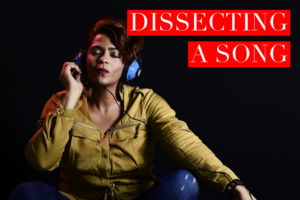
In line with our recent blogs on writing songs, song structure and the grammar of music, we’re now taking a look at how to dissect a song. The forensics of music is a key element of how we tutor, because we want our students to understand the bigger picture of a song and not just the role the instrument they play has, or the vocals if they are a singer.
The interplay of the instruments, the voice, the melody, and harmony make a song, along with the lyrics and even the look, style and attitude of the artist or band.
All of these elements create a reaction in a listener and make a song a hit or not.
We’re teaching out students to actively listen to songs to gain a deeper appreciation for the music, and seeing what elements make the song great.
However. We also teach our students that you don’t need a fancy studio and kit to be able to dissect a song and this is what this blog is about.
Listen
The very first, and possibly obvious step is to intentionally listen to music. By this, we mean, try to pick out all of the different instruments. Listen to the song on repeat and focus on one instrument at a time. Listen to how each instrument plays off the other and take notes about what you hear, liked and even, disliked.
We like to challenge our students and encourage them to listen to music out of their comfort zone. We get them to question what elements make that music genre different, or the same, as their favourite music style and, perhaps even, do they like it now?
Music theory
Songs are made up of pitch, duration, rhythm and tempo and recognising each of these elements is the beginning to understanding musical language.
Identifying the patterns in song can be as simple as tapping your foot along to the beat. Is there a pattern with the instruments? Is there a drum sequence repetition? A guitar solo? A piano intro?
We teach our students the vocabulary of music and it is very helpful to help dissect a song, knowing how all of the elements work together. For more information, please see our blog on The Grammar of Music.
Again, listening to a range of musical genres is a great way to train your ear and mind. Many classical pieces, written by composers such as Mozart and Beethoven provide a great way to learn and understand some of the terms.
Experiment
Our favourite three words – after Empower Through Music – are practice, practice, practice!
One of the best ways to learn to recognise elements of a song is to experiment and play on your chosen instrument or to sing. It’s the best way to help understand how music works. Singing or playing along to a song helps clarify how that instrument fits into the structure of the entire song, which then becomes a naturally recognisable way to analyse.
Many musicians purposely learn the guitar or piano, even the basics, in order to be able to experiment with different chords, rhythms and patterns.
Lyrics
Lyrics are a very personal preference. Some listeners focus on the lyrics and like a song purely based on the meaning behind them, while others do not even focus on the words and instead are drawn in by the melody and instruments. Indeed, some songs are purely instrumental and therefore have no place in a song.
Nevertheless, for those songs which have lyrics, which is the majority, we ask our students to think about the words – do they understand them? How does it make them feel? What happens to the song if they listen to it without the lyrics; does it have the same meaning? Are the words emotive or simply to add to the beat?
Looking at it in this way opens up many questions and really helps to evaluate the lyrics.
Harmeet May 15th, 2018
Posted In: Uncategorised